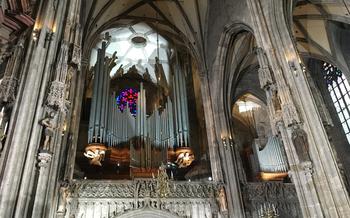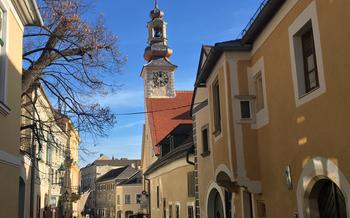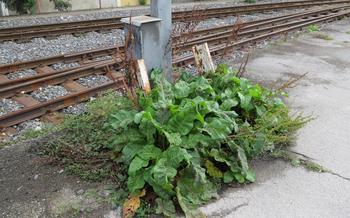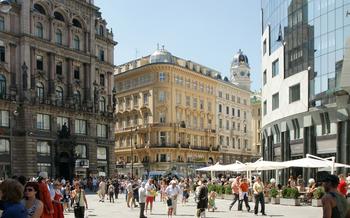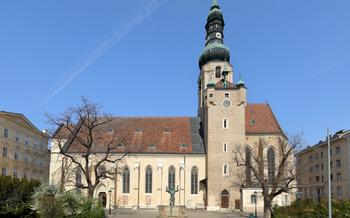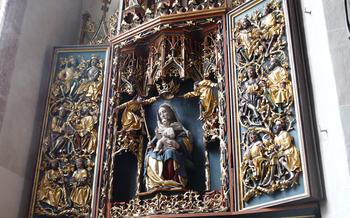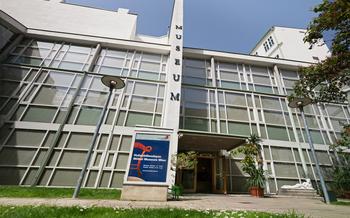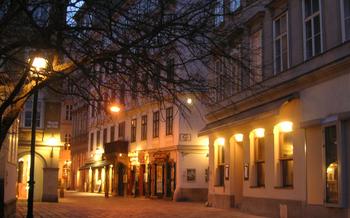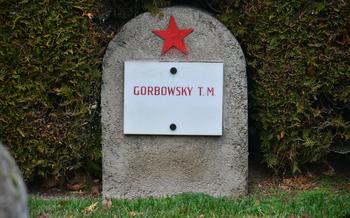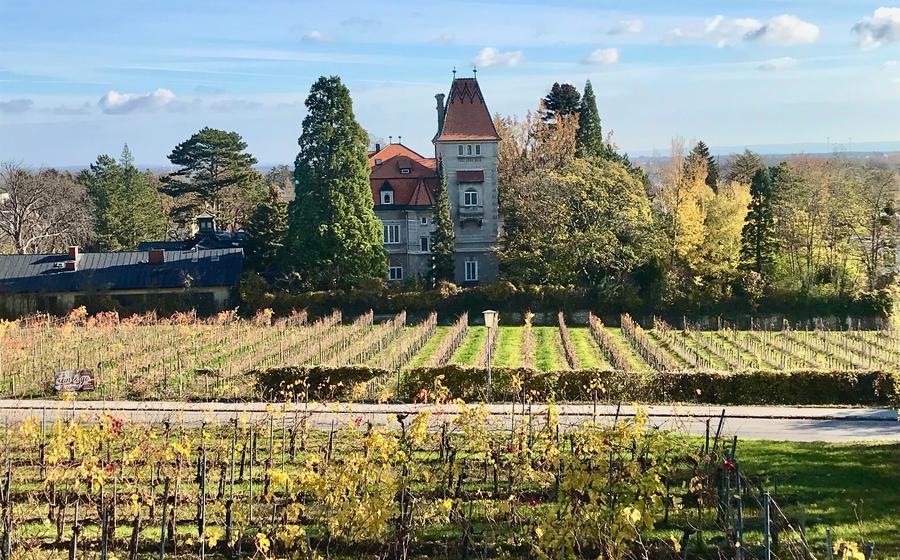
St. Stephen's Cathedral, Vienna
- St. Stephen's Cathedral: Vienna's Majestic Landmark
- Exploring the Cathedral's Interior
- A Journey Through History
- The Magnificent Altars
- Cathedral's Spiritual Significance
- Concerts and Events
- Practical Information
- Marveling at the Roof Mosaics
- Exploring the Treasury
- The Giant Organ:
- The Singer Tor:
- Nearby Attractions
- Insider Tip
St. Stephen's Cathedral: Vienna's Majestic Landmark
In the heart of Vienna, majestically towering over the city's skyline, stands St. Stephen's Cathedral, a Gothic masterpiece and a symbol of Austrian heritage. With its intricate spires piercing the sky and a rich history spanning centuries, this architectural marvel is not just a place of worship but a testament to Vienna's artistic, cultural, and spiritual significance.
St. Stephen's Cathedral holds a prominent place in Vienna's history, having served as the seat of the Catholic Archdiocese of Vienna since the 14th century. Its construction began in the 12th century and continued for over 600 years, resulting in a harmonious blend of Romanesque, Gothic, and Baroque architectural styles.
Over the centuries, the cathedral has witnessed countless historical events, coronations, weddings, and funerals of Austrian monarchs, cementing its status as a symbol of national identity. Its 136-meter-tall south tower, known as the Steffl, has become an iconic landmark of Vienna, offering breathtaking panoramic views of the city.
Beyond its historical significance, St. Stephen's Cathedral is a treasure trove of art and culture. Its interior boasts stunning stained-glass windows, intricate sculptures, and awe-inspiring ceiling frescoes, each telling a unique story from the Bible and Austrian history. The cathedral also houses the Pummerin Bell, Austria's largest bell, which rings out its majestic tones on special occasions, echoing through the streets of Vienna.
Exploring the Cathedral's Interior
Stepping inside St. Stephen's Cathedral is like stepping into a realm of awe-inspiring beauty. The cathedral's interior is a testament to the artistry and devotion of those who built it.
Stunning Stained-Glass Windows: The cathedral's stained-glass windows are a kaleidoscope of color and light. Depicting biblical scenes and historical events, these windows have survived centuries of wear and tear, still retaining their brilliance.
Intricate Sculptures and Artwork: Everywhere you look, you'll find intricate sculptures and artwork adorning the cathedral's interior. From the carved wooden choir stalls to the delicate stone carvings, each piece tells a story and adds to the cathedral's rich tapestry.
Impressive Ceiling Frescoes: Don't forget to look up and admire the stunning ceiling frescoes. Depicting scenes from the life of Christ and the Virgin Mary, these frescoes are a masterpiece of Renaissance art.
Visiting the Catacombs: Beneath the cathedral lies a hidden world—the catacombs. Here, you can explore the burial chambers of Habsburg royalty and noblemen, offering a glimpse into the history and traditions of Austria's past.
A Journey Through History
St. Stephen's Cathedral's origins can be traced back to the 12th century when a Romanesque church stood on the same site. However, the Gothic masterpiece we see today was largely constructed between the 14th and 16th centuries. Over the centuries, the cathedral has witnessed countless historical events and served as the stage for pivotal moments in Vienna's story.
In the 15th century, the cathedral played a crucial role during the reign of Emperor Frederick III, who was crowned Holy Roman Emperor within its hallowed walls. The 16th and 17th centuries brought periods of religious turmoil and Reformation conflicts, with St. Stephen's Cathedral remaining a staunch symbol of Catholicism.
During the Turkish siege of Vienna in 1683, the cathedral served as a refuge for the city's inhabitants. The Ottoman forces bombarded the city, causing significant damage to the cathedral, including the destruction of its Gothic spire. The spire was eventually rebuilt in the Baroque style, giving the cathedral its distinctive appearance today.
In the 19th century, St. Stephen's Cathedral underwent extensive renovations and restorations under the leadership of architect Friedrich von Schmidt. The cathedral survived the turbulent periods of World War I and II, although it sustained some damage during the Allied bombings. After the wars, meticulous restoration efforts were undertaken to return the cathedral to its former glory.
Today, St. Stephen's Cathedral stands as a testament to Vienna's rich history, having endured centuries of transformations and challenges. Its unique blend of architectural styles and its status as a religious and cultural landmark make it an integral part of the city's identity and a must-visit destination for travelers from around the world.
The Magnificent Altars
Within the grand interior of St. Stephen's Cathedral, a trio of awe-inspiring altars commands attention with their intricate craftsmanship and artistic grandeur. Each altar represents a unique style and holds deep significance within the cathedral's spiritual and historical narrative.
The High Altar, a masterpiece of Baroque artistry, takes center stage with its opulent design. Gilded angels, intricate carvings, and radiant colors adorn this magnificent altar, creating a breathtaking focal point within the cathedral's vast space.
In contrast, the Altar of the Crucifix presents a poignant and somber depiction of Christ's crucifixion. The life-size wooden figure of Jesus, suspended above the altar, evokes a sense of profound contemplation and reverence.
Finally, the Altar of St. Stephen, a Gothic treasure, pays homage to the cathedral's patron saint. Exquisitely crafted from stone, this altar showcases intricate carvings that narrate scenes from St. Stephen's life and martyrdom.
Cathedral's Spiritual Significance
St. Stephen's Cathedral has been the spiritual epicenter of Vienna for centuries, serving as the seat of the Catholic Archdiocese of Vienna. It has been the venue for countless religious ceremonies, including papal visits, ordinations, and weddings. The cathedral's impressive size and grandeur create a sense of awe and reverence, making it a popular destination for pilgrims and worshippers.
The cathedral's interior is adorned with intricate religious artwork and symbolism, reflecting its deep spiritual significance. The altarpieces, stained-glass windows, and sculptures depict biblical scenes and saints, inviting visitors to contemplate and connect with the divine. The cathedral's rich acoustics enhance the spiritual experience, making it an ideal setting for concerts, choral performances, and organ recitals that uplift and inspire.
Throughout history, St. Stephen's Cathedral has been a place of solace, reflection, and prayer for people from all walks of life. It has witnessed moments of triumph and tragedy, providing a sense of comfort and resilience to the Viennese community. The cathedral continues to be a symbol of faith and devotion, drawing visitors from around the world who seek spiritual enlightenment and connection.
Concerts and Events
St. Stephen's Cathedral is not just a place of worship but also a renowned venue for concerts and musical events. Its exceptional acoustics and awe-inspiring ambiance make it a sought-after location for world-class performances. Throughout the year, the cathedral hosts a diverse range of concerts, from classical to contemporary, featuring renowned musicians and choirs from around the globe.
Attending a concert at St. Stephen's Cathedral is an unforgettable experience. The music reverberates through the grand space, creating a truly immersive and emotional atmosphere. Whether you're a classical music enthusiast or simply looking for a unique cultural experience, the cathedral's concert calendar offers something for everyone.
To make the most of your visit, check the cathedral's website or consult local event guides for upcoming concerts and events. Advance booking is recommended to secure your seats, especially for popular performances. Immerse yourself in the magic of music within the hallowed halls of St. Stephen's Cathedral and create memories that will last a lifetime.
Practical Information
Location and accessibility:
St. Stephen's Cathedral is located in the heart of Vienna's historic center, Stephansplatz.
Marveling at the Roof Mosaics
St. Stephen's Cathedral's roof is adorned with a remarkable collection of mosaics, showcasing intricate patterns, vibrant colors, and biblical scenes. These mosaics, created using millions of colorful tiles, are a testament to the artistic and technical prowess of medieval craftsmen.
The most prominent mosaic is the "Last Judgment," located on the south side of the roof. This awe-inspiring masterpiece depicts Christ presiding over the final judgment of humanity, surrounded by angels, saints, and the twelve apostles. Other mosaics portray scenes from the life of Jesus, the Virgin Mary, and various saints.
One of the unique aspects of these mosaics is their three-dimensional effect. The tiles are arranged in a way that creates a sense of depth and movement, making the figures appear to come to life. This technique, known as "opus sectile," was commonly used in Byzantine and Romanesque art and is a testament to the skill and artistry of the mosaicists.
To fully appreciate the splendor of these mosaics, take some time to observe them from different angles. As the light changes throughout the day, the colors and shadows shift, revealing new details and perspectives. It's a truly mesmerizing sight that will leave you in awe of the artistry and craftsmanship of the past.
Exploring the Treasury
St. Stephen's Cathedral houses a remarkable treasury that holds a treasure trove of sacred artifacts, relics, and precious objects. This collection offers a glimpse into the rich history and religious significance of the cathedral, showcasing items that have been carefully preserved and revered for centuries.
Among the highlights of the treasury are the reliquaries, which contain the remains of saints and martyrs. These exquisitely crafted containers are adorned with intricate decorations and jewels, demonstrating the artistry and devotion of past craftsmen. Visitors can also admire a collection of reliquaries, which house fragments of the True Cross and other holy relics, evoking a sense of awe and reverence.
The treasury also boasts a collection of medieval manuscripts, illuminated with vibrant colors and intricate illustrations. These precious documents provide a window into the religious and cultural life of the Middle Ages, showcasing the skill and dedication of scribes and illuminators.
Access to the treasury is typically included in guided tours of the cathedral, allowing visitors to learn more about the history and significance of these sacred artifacts. It is important to note that photography is often restricted in the treasury to preserve the integrity and sanctity of the collection.
The Giant Organ:
The St. Stephen's Cathedral is home to one of the world's largest organs, a monumental instrument that fills the vast interior with its majestic sound. Constructed in the 19th century, the organ comprises over 10,000 pipes, spread across four manuals and 130 stops. Its colossal dimensions and intricate mechanics make it a masterpiece of organ building.
The organ's impressive size and power are immediately evident upon entering the cathedral. Its towering presence commands attention, with pipes of varying lengths and diameters arranged in a symmetrical array. The console, from which the organist controls the instrument, is a marvel of craftsmanship, featuring ivory keys, ebony stop knobs, and ornate carvings.
The sound produced by the organ is awe-inspiring, enveloping the cathedral in a rich tapestry of tones and harmonies. From the gentle whispers of the softest registers to the thunderous roar of the full organ, the music fills the air with a sense of grandeur and spirituality.
Regular concerts and performances showcase the talents of renowned organists from around the world, allowing visitors to experience the full potential of this magnificent instrument. Whether you're a music enthusiast or simply seeking a moment of tranquility, the St. Stephen's Cathedral organ promises an unforgettable auditory experience.
The Singer Tor:
The south side of St. Stephen's Cathedral is adorned by the impressive Singer Tor, an ornate Gothic portal that serves as a grand entrance to the sacred space. Its intricate carvings and detailed sculptures narrate biblical stories and depict saints and apostles with remarkable artistry. The portal's name, "Singer Tor," originates from the minnesingers, medieval poets, and musicians who once performed here, captivating audiences with their enchanting melodies.
For centuries, the Singer Tor has stood as a testament to the cathedral's rich history and artistic heritage. While its original purpose was to provide a ceremonial entrance for processions and important events, today it remains a significant architectural element that draws the attention of visitors from around the world.
Comparing the Singer Tor to other Gothic portals in Europe reveals its unique characteristics and symbolism. While it shares similarities in terms of its pointed arch and intricate carvings, the Singer Tor stands out for its emphasis on narrative storytelling through its sculptures. Each figure and scene depicted on the portal holds a specific meaning and contributes to the overall spiritual and theological message conveyed by the cathedral.
Whether you're a history buff, an architecture enthusiast, or simply a curious traveler, the Singer Tor is an unmissable highlight of St. Stephen's Cathedral. Take a moment to admire its intricate details and imagine the stories they hold, transporting you back to a time when minnesingers filled the air with their enchanting melodies.
Nearby Attractions
St. Stephen's Cathedral is surrounded by a wealth of cultural and historical treasures that enhance its allure. Take advantage of your visit to explore these nearby attractions:
-
Hofburg Palace: Just a short walk away, the imperial residence of the Habsburg dynasty offers a glimpse into the grandeur of the past. Explore its opulent rooms, admire the imperial collection, and witness the Changing of the Guard ceremony.
-
Spanish Riding School: Renowned for its elegance and precision, the Spanish Riding School is a must-see for equestrian enthusiasts. Watch the world-famous Lipizzaner stallions perform intricate dressage routines in the historic riding arena.
-
Museums Quartier: A vibrant hub of art and culture, the Museums Quartier is home to several world-class museums, including MUMOK (Museum of Modern Art), Leopold Museum, and Kunsthalle Wien. Immerse yourself in contemporary and classical art exhibitions, thought-provoking installations, and inspiring architecture.
-
Exploring the Surrounding Area: Beyond these iconic attractions, the streets surrounding St. Stephen's Cathedral are filled with charming cafes, boutiques, and historical landmarks. Wander through the narrow alleys, admire the Baroque architecture, and stumble upon hidden gems that reveal the true essence of Vienna.
Insider Tip
To elevate your experience at St. Stephen's Cathedral, consider joining a guided tour. These tours provide a wealth of historical and architectural insights, allowing you to discover hidden stories and appreciate the cathedral's significance. Additionally, plan your visit to coincide with one of the regular concerts or events held within the cathedral's hallowed halls. These events offer a unique opportunity to experience the cathedral's world-renowned acoustics and witness the transformative power of music in this sacred space.
As darkness descends upon Vienna, St. Stephen's Cathedral takes on a new allure. The exterior illuminations cast a warm glow, highlighting the intricate details of its Gothic facade. Take advantage of this magical ambiance to capture stunning photographs and marvel at the cathedral's beauty under the night sky.
Venture beyond the immediate vicinity of the cathedral to uncover hidden gems and charming spots that encapsulate Vienna's rich history and vibrant culture. Explore the narrow cobblestone streets, visit quaint cafes, and stumble upon hidden courtyards that offer a glimpse into the city's past. Allow yourself to get lost in the charm of Vienna, and discover the unexpected treasures that await around every corner.
